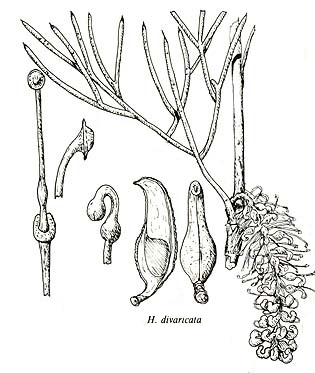Family: Proteaceae
Hakea divaricata
Citation:
L. Johnson, Contr. N.S.W. hath. Herb. 3:93 (1962).
Synonymy: Hakea ivoryi Bailey var. glabrescens J. Black, Trans. R. Soc. S. Aust. 61:242 (1937); Hakea intermedia Ewart & O.B. Davies, Fl. North. Terr. 86 (1917), non Hook.; Hakea ivoryi sensu J. Black, FI.S. Aust. 264 (1948), auct. non Bailey; Hakea eyreana sensu Boomsma, Native trees of South Australia 261 (1981), partly, auct. non (S. Moore) McGillivray.
Common name: Corkbark, corkbark tree.
Description:
Crooked-boled tree or shrub to 6 m high with furrowed corky bark; branchlets red, glabrous, sometimes sparsely rarely densely pubescent; leaves compound, rarely simple, 7-20 cm usually 9-16 cm long, terete, rarely slightly flattened, mid-green, glabrous or sparsely pubescent and glabrescent, petiole 2.5-9 cm long, initial divisions dichotomous or trichotomous, final divisions dichotomous, final segments 1-16 usually 3-13, not spreading as widely as in Hakea eyreana, 0.3-12 cm usually 2-9 cm X 0.85-2.3 mm, apex straight, rarely hooked, mucro 1-3.5 rarely to 5 mm long.
Inflorescence a raceme of 65-120 yellow flowers, ash-white in bud; rhachis, pedicel and perianth externally usually sparsely sometimes densely eglandular- and/or glandular-pubescent, sometimes glabrous; rhachis 5-14 cm long; pedicel 4-10 mm long; perianth 5.5-9 mm long, reflexed in the mature bud, limb 1.8-2.4 mm long; anthers 1-1.2 mm long; gland 1.8-2.5 mm long laterally; pistil 21-26 mm long, sometimes becoming hairy after anthers; style soon erect; pollen-presenter almost lateral, the disc 1.5-1.8 mm long, narrow, undulate, the cone 0.5-1 mm high.
Fruit narrow-ovoid, 2.3-4 X 0.8-1.4 cm, smooth, glabrous or glabrescent, with a very long often curved broad beak, terminated abruptly by a short oblique narrow beak to 3 mm long, horns obscure, dehiscence fully down both sides, with 1 rarely 2 layers of yellow to dark-brown wood beside the seed cavity; seed (from cavity) 19-32 X 7-11 mm, body 8-13 mm long, ridge lateral, short, wing decurrent up to halfway down the other side.

| twigs, buds, pistils and pollen presenters and internal face and external median views of fruits
|
Image source: fig. 75a in Jessop J.P. & Toelken H.R. (Ed.) 1986. Flora of South Australia (4th edn).
|
|
|
Distribution:
|
In red sand-plains around hill bases or rockholes, in woodland.
S.Aust.: NW. W.Aust.; N.T.
|
Conservation status:
native
Flowering time: June — Nov.
|

SA Distribution Map based
on current data relating to
specimens held in the
State Herbarium of South Australia
|
Biology:
No text
Taxonomic notes:
The description encompasses material from S.Aust. and adjacent, parts of W.Aust. and N.T. A closely allied taxon occurs in the MacDonnell Ranges, N.T., and northwards, diverging by its shorter leaves 4-10 cm usually 5-9.5 cm long, with usually 5-18 segments 0.05-6.5 cm long. H. ivoryi, to which this species has been referred until recently, is confined to south-west Qld and northern N.S.W. and diverges by its tall tree habit, its more slender branchlets with an appressed pubescence, and its often simple more flexible leaves.
Author:
Not yet available
|

